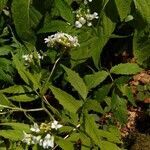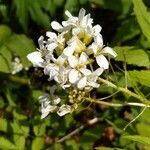Herbs perennial, 25-75 cm tall, sparsely to densely villous. Rhizomes creeping, slender, not scaly or stoloniferous. Stems simple, flexuous. Cauline leaves 4-7, including petiole (8-)10-20(-25) cm; petiole (1-)2-8(-10) cm, not auriculate at base; terminal leaflet lanceolate, elliptic, to ovate-elliptic, (3-)4-9(-13) × (0.6-)1-3.5(-4) cm, adaxially shortly strigose or puberulent, abaxially pilose or long strigose, with a petiolule 5-13(-20) mm, base cuneate, margin antrorsely ciliate and irregularly serrate, doubly serrate, or subdentate, apex acuminate or rarely acute; lateral leaflets 2 or 3 pairs, rarely uppermost leaf trifoliolate, similar to terminal one, smaller, sessile, base cuneate or sometimes oblique. Racemes 12-24-flowered. Fruiting pedicels divaricate or ascending, (0.5-)1-1.8(-2.3) cm, pilose or puberulent, slender. Sepals oblong, (2-)2.5-3.5 × 0.9-1.5 mm, margin membranous, pilose abaxially. Petals white, spatulate to oblong-oblanceolate, 6-8 × 2-3.5(-4) mm, cuneate and not clawed at base, apex rounded. Median filament pairs 5-6 mm, lateral pair 4-5 mm; anther oblong, 0.8-1.3 mm. Ovules 6-12 per ovary. Fruit linear, (1-)1.5-3 cm × 1-1.5 mm; gynophore 0.3-0.8(-1) mm; valves smooth, sparsely hairy or glabrous; style slender, (2-)3-5 mm. Seeds brown, oblong, 1.5-2.2 × 0.8-1.2 mm, narrowly winged or wingless. Fl. Apr-Jul, fr. May-Aug. 2n = 16.
More
A cabbage family herb. It keeps growing from year to year. It grows from 25-70 cm tall. It is hairy. There are 2-3 leaves near the base. These are compound with leaflets along the stalk. There are 5-7 leaflets. The end leaflet is 4-6 cm long and 1-3 cm wide. The leaves on the stem are smaller. The flowers are white and in groups at the top of the plant. The pods are hairy and 1.5-2.5 cm long by 1.5 mm wide. The seeds are brown and 2 mm long.
It is a temperate plant. It grows on roadsides, shady areas, forests, wet places along streams, roadsides between 100–2000 m. altitude in China. It grows in wetlands.
More
Wet places by ponds and streams, in mountains all over Japan.


